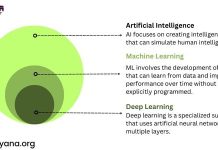Artificial Intelligence has shown immense progress in the last decade and still, it is evolving. Machine learning is one of the important fields of AI. Machine learning allows the computer(machines) to learn without being explicitly programmed. But we don’t realize how machines are working to give outputs. It all depends upon the lifecycle of the machine. Machine learning follows a lifecycle. So In this article, I will discuss the lifecycle of Machine learning.
Machine learning lifecycle is divided into the following types
- Data Collection
- Preparation of data
- Wrangling of data
- Analysis of data
- Training of data
- Test of data
- Data deployment
Data Collection
Here data from the varied resources get collected. In this step, various resources are identified that contains data. The data can be from any source like mobile, internet, database, datawarehouse anything. If you want that the outcomes are of high quality, choose the data source accordingly. For this firstly, you need to recognize different data sources, then you have to collect data from them and at last you can simply integrated the data. Now you’re all set to move further.
Preparation of data
When you gathered the appropriate data, then it is a time to get that data ready for further steps. For this step, firstly you need to all data together, and then work on the ordering of data. This step is further distinguished into next steps:-
a) Data discovery:- In data discovery, simply follow these things
- Understand the nature of your data.
- Determine its features.
- Check out its format.
- The most important thing is to examine its quality.
If this process carries out smoothly, you can find outliers there.
b) Data pre-processing:
Here all the processing work is done.
Also See: Artificial intelligence- Fuzzy Logic System
Wrangling of data
Wangling of data means to clean and transform the raw data into useable format. In simple terms, it is a process in which cleaning of data, choosing the appropriate feature and tranformation of the data is done. Cleaning of data is performed so as to eradicate unwanted noise. The data which we have collected may contain the following things
- Noise
- Distortion
- Missing value
- Invalid value
- Duplicate data
- That is why filtering techniques are recommended.
Analysis of data
This is based on selecting the relevant analytical technique, creating models and last but not the least reviewing the results. Machine learning follows CART. This means classification and regression tree. Also it includes ARM(Association rule mining) and clustering techniques.
In this step, these machine learning algorithms are used for building the model.
Training of data
Here model is trained, so that it can easily recognize various patterns, features and rules. In this part, you have to deploy datasets, so that training can be applied on them. The main motive is to improve the performance of the sytem.
Test of data
After training, testing is done. As testing allows to determine how accurately the machine is working for given parameters. There are various performance parameters like accuracy, precision, F1 score, Average and others.
Data deployment
Data deployment involves the final working. It is mandatory to follow the above steps. In the final steps after testing, your system is all set to get executed.
Also check: Expert System in Artificial intelligence
Conclusion
Machine learning involves various steps that one should considered before implementing work on it. In this article, I’ve discussed the machine learning lifecycle. If you are having any doubt, ask me freely in the comment section.











